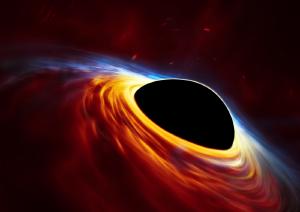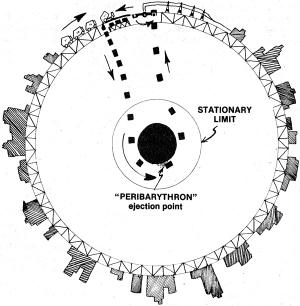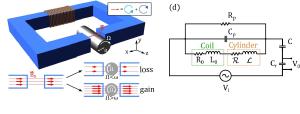Blog
The Dark Power
21 September 2024
 ESO, ESA/Hubble, M. Kornmesser
ESO, ESA/Hubble, M. KornmesserWhen you get close to a black hole, things can get pretty intense. The tremendous gravity can squeeze gas to ionizing temperatures, and fierce magnetic fields can accelerate plasma into jets speeding at nearly the speed of light. That’s a lot of power, and wherever there is power someone will figure out how to harness it.
 Atomic Rockets, adapted from Misner, Thorne and Wheeler
Atomic Rockets, adapted from Misner, Thorne and WheelerBack in 1969 Roger Penrose noted that you could theoretically extract energy from a black hole simply by dumping garbage into it.1 The idea was to pack a spaceship full of junk, fly really close to a black hole so that you travel within the region of strongly twisted space known as the ergosphere, then simply dump your trash. The trash gets consumed by the black hole and your spaceship gets a boost of energy. No need to reduce, reuse, recycle, just toss it down the cosmic hole.
While this should work in principle, the engineering needed to carry it off would be challenging, and harnessing energy from a fast-moving rocket wouldn’t be very efficient. Fortunately there should be another way, just using electromagnetic waves. In 1971 Yakov Zeldovich demonstrated how a rotating black hole could amplify electromagnetic waves. Essentially if you beam light toward a rotating black hole, some of the light will be ampified due to the frame dragging of gravity.2
At least in theory.
Therein lies the problem. While all of this is theoretically sound, we don’t have a spare black hole lying around to prove it. Luckily the Zeldovich effect works for more than just black holes. Zeldovich showed that the effect should work for any rotating body that absorbs a bit of the energy aimed at it. So you should be able to bounce light against a rotating cylinder and see the effect. No black hole needed. The only problem is that the cylinder would need to rotate at relativistic speeds and the effect would be tiny. Then in 2020 a team showed how a similar effect worked with sound waves.3 They beamed low-frequency sound waves into an absorptive rotating disk and measured an increase in acoustic energy, proving the Zeldovich effect worked for sound.
 Braidotti, et al
Braidotti, et alNow the team is back with a new paper showing the effect with electromagnetic waves.4 The way they did it was to adapt a resonant circuit. The circuit could focus an oscillating magnetic wave through a through an aluminum cylinder. By itself the cylinder would act as a simple resistor and dampen the magnetic field, but when the team rotated the cylinder in a particular way the magnetic field was amplified just as Zeldovich predicted. Since aluminum isn’t magnetic, the isn’t due to some dynamo effect. Thus the team could demonstrate it is a new effect.
So we now know rotating bodies, including black holes, can amplify electromagnetic fields. What’s also interesting about this experiment is how surprisingly straight forward it is. The design is similar to an induction generator used in wind turbines. The experiment could have been done decades ago, it’s just that no one had thought of it before. Sometimes the answer to a scientific question is right in front of you.
Penrose, R. “Gravitational collapse: The role of general relativity.” (1969): 252-276. ↩︎
Zeldovich, Y. B. “Generation of waves by a rotating body.” JETP Letters 14 (1971): 180. ↩︎
Cromb, Marion, et al. “Amplification of waves from a rotating body.” Nature Physics 16.10 (2020): 1069-1073. ↩︎
Braidotti, M. C., et al. “Amplification of electromagnetic fields by a rotating body.” Nature Communications 15.1 (2024): 5453. ↩︎